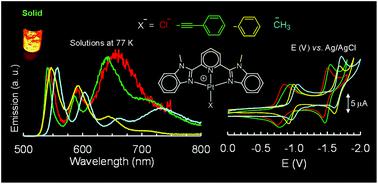当前位置:
X-MOL 学术
›
Dalton Trans.
›
论文详情
Our official English website, www.x-mol.net, welcomes your
feedback! (Note: you will need to create a separate account there.)
Luminescent Pt(2,6-bis(N-methylbenzimidazol-2-yl)pyridine)X+: a comparison with the spectroscopic and electrochemical properties of Pt(tpy)X+ (X = Cl, CCPh, Ph, or CH3).
Dalton Transactions ( IF 3.5 ) Pub Date : 2020-06-25 , DOI: 10.1039/d0dt01496f Vikas M Shingade 1 , Levi J Grove 1 , William B Connick 1
Dalton Transactions ( IF 3.5 ) Pub Date : 2020-06-25 , DOI: 10.1039/d0dt01496f Vikas M Shingade 1 , Levi J Grove 1 , William B Connick 1
Affiliation

|
A series of platinum(II) pincer complexes of the formula Pt(mbzimpy)X+, 1(a–d), (mbzimpy = 2,6-bis(N-methylbenzimidazol-2-yl)pyridine; X = Cl; (a), CCPh; (b), Ph; (c), or CH3; (d), CCPh = phenylacetylide, and Ph = Phenyl) have been synthesized and characterized. Electronic absorption and emission, as well as electrochemical properties of these compounds, have been investigated. Pt(tpy)X+ analogs (tpy = 2,2′;6′2′′-terpyridine), 2(a–d), have also been investigated and compared. Electrochemistry shows that 1 and 2 analogs undergo two chemically reversible one-electron reduction processes that are shifted cathodically along the a < b < c < d series. Notably, these reductions occur at slightly higher negative potentials in the case of 1. The absorption spectra of 1 and 2 in acetonitrile exhibit ligand-centered (1LC) transitions (ε ≈ 104 M−1 cm−1) in the UV region and metal-to-ligand-charge transfer (1MLCT) transitions (ε ≈ 103 M−1 cm−1) in the visible region. The corresponding visible bands of 1b and 2b have been assigned to 1(LLCT/MLCT) mixed state (LLCT: ligand-to-ligand-charge transfer). The preceding 1LC and 1MLCT transitions of 1 occur at lower energies than that of 2. These 1LC transitions have distinctly been blue-shifted along a < c < d in 2, but occur at nearly identical energies in 1. Conversely, 1MLCT transitions are red-shifted along a < c < d in both the analogs. The 77 K glassy solutions of 1 and 2 exhibit an intense vibronically-structured emission band at λmax(0–0) in the 470–560 nm range. This band is red-shifted along b < a ≤ c < d in 1 and along a ≤ d ≈ c ≪ b in 2. The main character of these emissions is assigned to 3LLCT emissive state in 1b and 2b, whereas to 3LC in the rest of the compounds. Relative stabilization of these spin-forbidden emissive states is discussed by invoking configuration mixing with the higher-lying 3MLCT state.
中文翻译:

发光Pt(2,6-双(N-甲基苯并咪唑-2-基)吡啶)X +:与Pt(tpy)X +的光谱和电化学性质比较(X = Cl,CCPh,Ph或CH3)。
一系列铂(的II式)钳形络合物的Pt(mbzimpy)X +,图1(a-d) ,(mbzimpy = 2,6-双(Ñ -methylbenzimidazol -2-基)吡啶; X =氯;(a),CCPh;(b),Ph;(c)或CH 3;(d),CCPh =苯乙炔,Ph =苯基)已经合成并表征。已经研究了这些化合物的电子吸收和发射以及电化学性质。Pt(tpy)X +类似物(tpy = 2,2'; 6'2''-叔吡啶)2(a–d)也已进行了研究和比较。电化学表明1和2类似物经历两个化学可逆的单电子还原过程,这些过程沿a <b <c <d系列进行阴极移位。值得注意的是,在1的情况下,这些降低发生在负电位稍高的位置。的吸收光谱1和2中显示出乙腈配体为中心的(1 LC)转变(ε听,说:10 4中号-1厘米-1)在UV区和金属-配体电荷转移(1 MLCT)跃迁(ε ≈10 3 M -1 cm -1)。对应的可见带1b和2b已分配给1(LLCT / MLCT)混合状态(LLCT:配体到配体电荷转移)。前述1个LC和1个的MLCT跃迁1发生在比的较低能量2。这些1个LC跃迁都明显是蓝移沿<C <d在2,但在几乎相同的能量发生1。相反,两个模拟物中的1 MLCT跃迁均沿<c <d红移。的77K的玻璃态溶液1个2表现出强烈的vibronically结构发射带在λ最大在470-560 nm范围内为(0-0)。沿B该带红移<一个≤ç<d在1和沿着≤d≈Ç«b在2。这些排放的主要字符被分配给3 LLCT发射状态在图1b和2b中,而以3 LC中的化合物的其余部分。通过调用与较高位置的3 MLCT状态混合的构型,讨论了这些自旋禁止发射态的相对稳定。
更新日期:2020-07-21
中文翻译:

发光Pt(2,6-双(N-甲基苯并咪唑-2-基)吡啶)X +:与Pt(tpy)X +的光谱和电化学性质比较(X = Cl,CCPh,Ph或CH3)。
一系列铂(的II式)钳形络合物的Pt(mbzimpy)X +,图1(a-d) ,(mbzimpy = 2,6-双(Ñ -methylbenzimidazol -2-基)吡啶; X =氯;(a),CCPh;(b),Ph;(c)或CH 3;(d),CCPh =苯乙炔,Ph =苯基)已经合成并表征。已经研究了这些化合物的电子吸收和发射以及电化学性质。Pt(tpy)X +类似物(tpy = 2,2'; 6'2''-叔吡啶)2(a–d)也已进行了研究和比较。电化学表明1和2类似物经历两个化学可逆的单电子还原过程,这些过程沿a <b <c <d系列进行阴极移位。值得注意的是,在1的情况下,这些降低发生在负电位稍高的位置。的吸收光谱1和2中显示出乙腈配体为中心的(1 LC)转变(ε听,说:10 4中号-1厘米-1)在UV区和金属-配体电荷转移(1 MLCT)跃迁(ε ≈10 3 M -1 cm -1)。对应的可见带1b和2b已分配给1(LLCT / MLCT)混合状态(LLCT:配体到配体电荷转移)。前述1个LC和1个的MLCT跃迁1发生在比的较低能量2。这些1个LC跃迁都明显是蓝移沿<C <d在2,但在几乎相同的能量发生1。相反,两个模拟物中的1 MLCT跃迁均沿<c <d红移。的77K的玻璃态溶液1个2表现出强烈的vibronically结构发射带在λ最大在470-560 nm范围内为(0-0)。沿B该带红移<一个≤ç<d在1和沿着≤d≈Ç«b在2。这些排放的主要字符被分配给3 LLCT发射状态在图1b和2b中,而以3 LC中的化合物的其余部分。通过调用与较高位置的3 MLCT状态混合的构型,讨论了这些自旋禁止发射态的相对稳定。






























 京公网安备 11010802027423号
京公网安备 11010802027423号